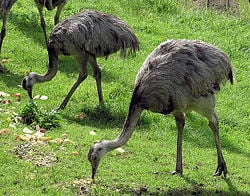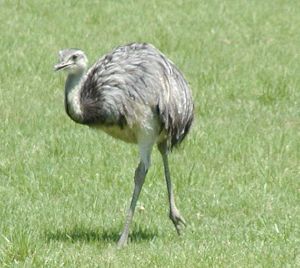Rhea (bird)
| Rhea
| ||||||||||||||
|---|---|---|---|---|---|---|---|---|---|---|---|---|---|---|
 American Rhea, Rhea americana
| ||||||||||||||
| Scientific classification | ||||||||||||||
| ||||||||||||||
|
The rheas are ratites (flightless birds, with unkeeled sterna) in the genus Rhea, native to South America. There are two existing species: the Greater or American Rhea and the Lesser or Darwin's Rhea. The genus name was given in 1752 by Paul Möhring and adopted as the English common name. Möhring's reason for choosing this name, from the Rhea of classical mythology, is not known.
Description
Rheas are large, flightless birds with gray-brown plumage, long legs and long necks, similar to an ostrich. These birds can reach 5.6 feet (1.7 m), and weigh up to 88 pounds (40 kg).[2][3] Their wings are large for a flightless bird and are spread while running, to act like sails.[4] Unlike most birds, rheas have only three toes. Their tarsus has horizontal plates on the front of it. They also store urine separately in an expansion of the cloaca.[3]
Taxonomy
The recognized extant species are:
- Greater Rhea Rhea americana
- R. a. americana, found in campos of northern and eastern Brazil.[5]
- R. a. intermedia, southeastern Brazil in Rio Grande do Sul and Uruguay.[5]
- R. a. nobilis, eastern Paraguay, east of Rio Paraguay.[5]
- R. a. araneipes, chaco of Paraguay to Bolivia and Mato Grosso in Brazil.[5]
- R. a. albescens, plains of Argentina south to Rio Negro.[5]
- Lesser Rhea Rhea pennata
Rhea pennata was not always in the Rhea genus. In 2008 the SACC, the last holdout, approved the merging of the genera, Rhea and Pterocnemia on August 7, 2008. This merging of genera leaves only the Rhea genus.[6] A third species of rhea, Rhea nana, was described by Lydekker in 1894 based on a single egg found in Patagonia,[7] but today no major authorities consider it valid.
Behavior
Individual and flocking
Rheas tend to be silent birds with the exception being when they are chicks or when the male is seeking a mate. During the non-breeding season they may form flocks of between 10 and 100 birds, although the lesser rhea forms smaller flocks than this. When in danger they flee in a zig-zag course, utilizing first one wing then the other, similar to a rudder. During breeding season the flocks break up.[3]
Diet
They are omnivorous and prefer to eat broad-leafed plants, but also eat seeds, roots, fruit, lizards, beetles, grasshoppers, and carrion.[3]
Reproduction
Rheas are polygamous, with males courting between two and twelve females. After mating, the male builds a nest, in which each female lays her eggs in turn. The nest consists of a simple scrape in the ground, lined with grass and leaves.[4] The male incubates from ten to sixty eggs. The male will utilize a decoy system and place some eggs outside the nest and sacrifice these to predators, so that they won't attempt to get inside the nest. The male may utilize another subordinate male to incubate his eggs, while he finds another harem to start a second nest.[3] The chicks hatch within 36 hours of each other. The females, meanwhile, may move on and mate with other males. While caring for the young, the males will charge at any perceived threat that approach the chicks including female rheas and humans. The young reach full adult size in about six months but do not breed until they reach two years of age.[4]
Human interaction
Rheas have many uses in South America. Feathers are used for feather dusters, skins are used for cloaks or leather, and their meat is a staple to many people.[3]
Footnotes
ReferencesISBN links support NWE through referral fees
- Brands, Sheila (Aug 14 2008). Systema Naturae 2000 / Classification, Family Rheidae. Project: The Taxonomicon. Retrieved Feb 04 2009.
- (2007) The Clements Checklist of the Birds of the World, 6, Ithaca, NY: Cornell University Press. ISBN 978 0 8014 4501 9.
- Davies, S.J.J.F.. (2003). "Rheas". Grzimek's Animal Life Encyclopedia (2) 8 Birds I Tinamous and Ratites to Hoatzins: 69–71. Ed. Hutchins, Michael. Farmington Hills, MI: Gale Group.
- Davies, S.J.J.F. (1991). in Forshaw, Joseph: Encyclopaedia of Animals: Birds. London: Merehurst Press, 47–48. ISBN 1-85391-186-0.
- (1994) Extinct and Endangered Birds in the Collections of the Natural History Museum, British Ornithologists' Club Occasional Publications. British Ornithologists' Club.
- (1835) An introduction to study of birds. London, UK: Chiswick.
- Remsen Jr., J. V.; et al. (07 Aug 2008). Classification of birds of South America Part 01:. South American Classification Committee. American Ornithologists' Union. Retrieved 04 Feb 2009.
External links
- Rhea videos on the Internet Bird Collection
Credits
New World Encyclopedia writers and editors rewrote and completed the Wikipedia article in accordance with New World Encyclopedia standards. This article abides by terms of the Creative Commons CC-by-sa 3.0 License (CC-by-sa), which may be used and disseminated with proper attribution. Credit is due under the terms of this license that can reference both the New World Encyclopedia contributors and the selfless volunteer contributors of the Wikimedia Foundation. To cite this article click here for a list of acceptable citing formats.The history of earlier contributions by wikipedians is accessible to researchers here:
The history of this article since it was imported to New World Encyclopedia:
Note: Some restrictions may apply to use of individual images which are separately licensed.


